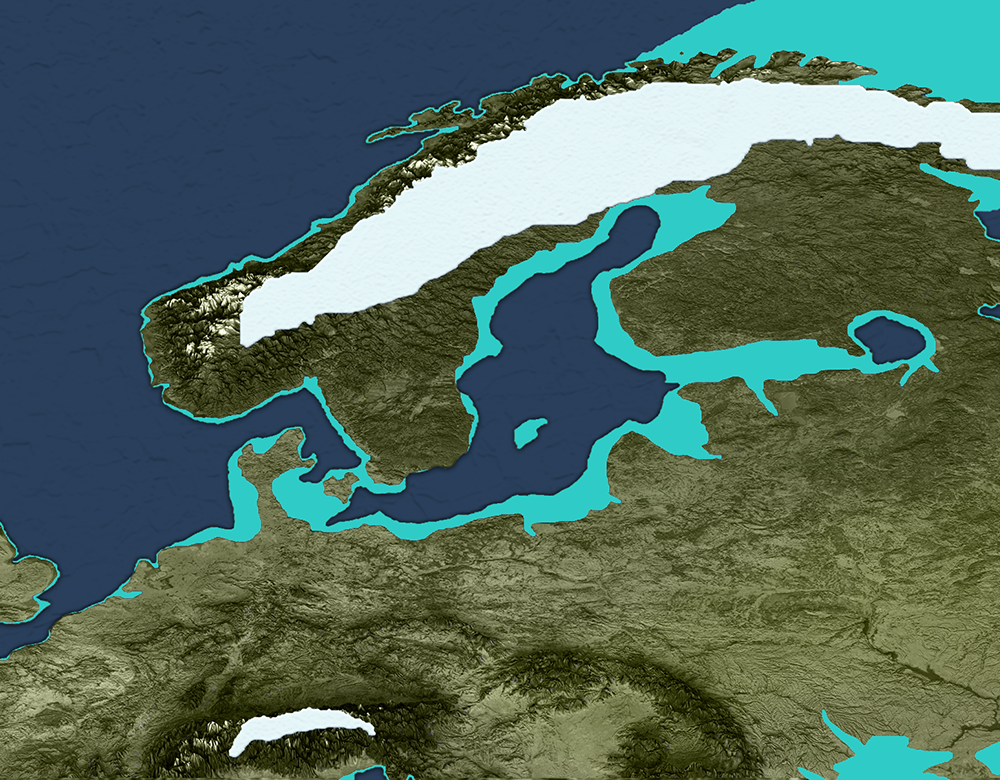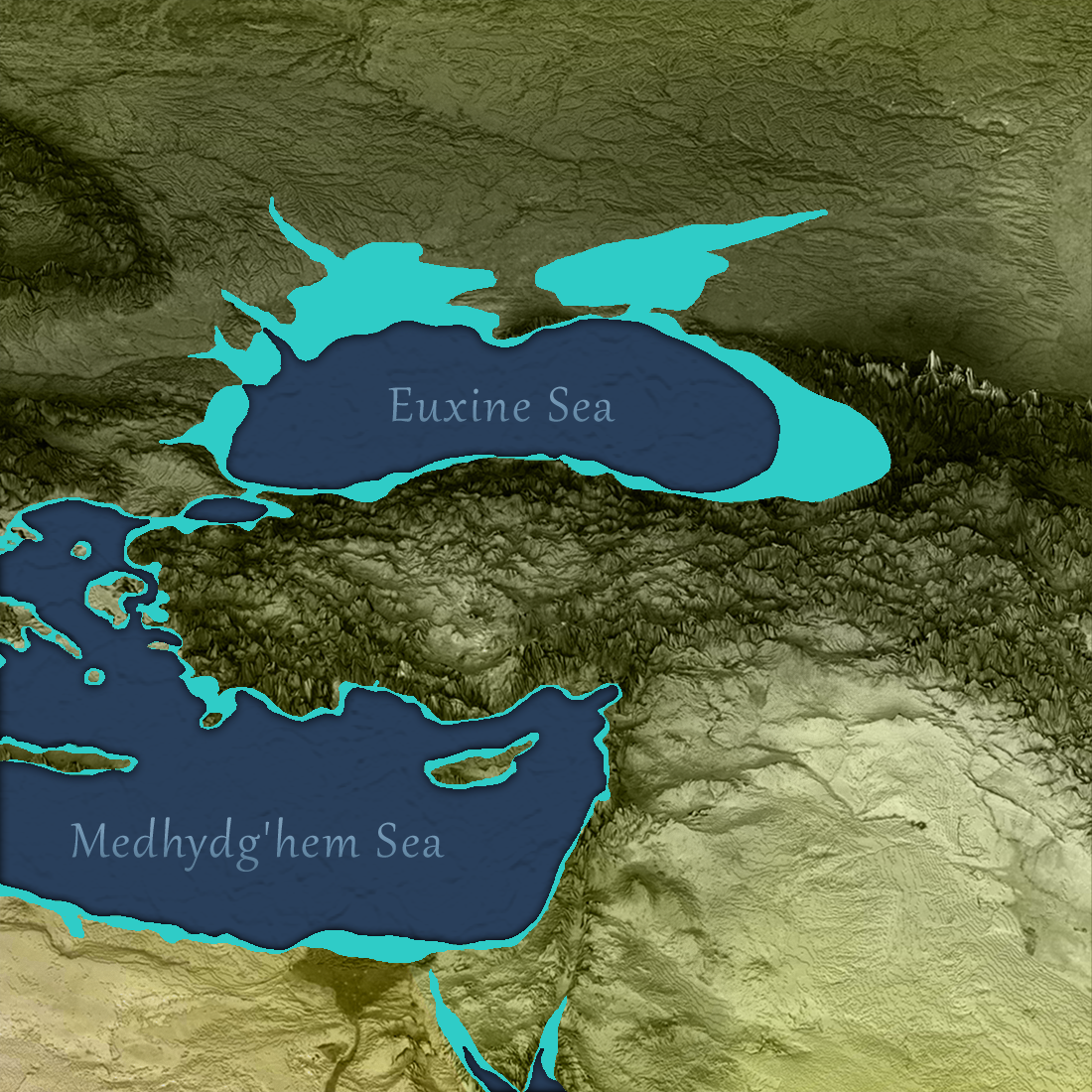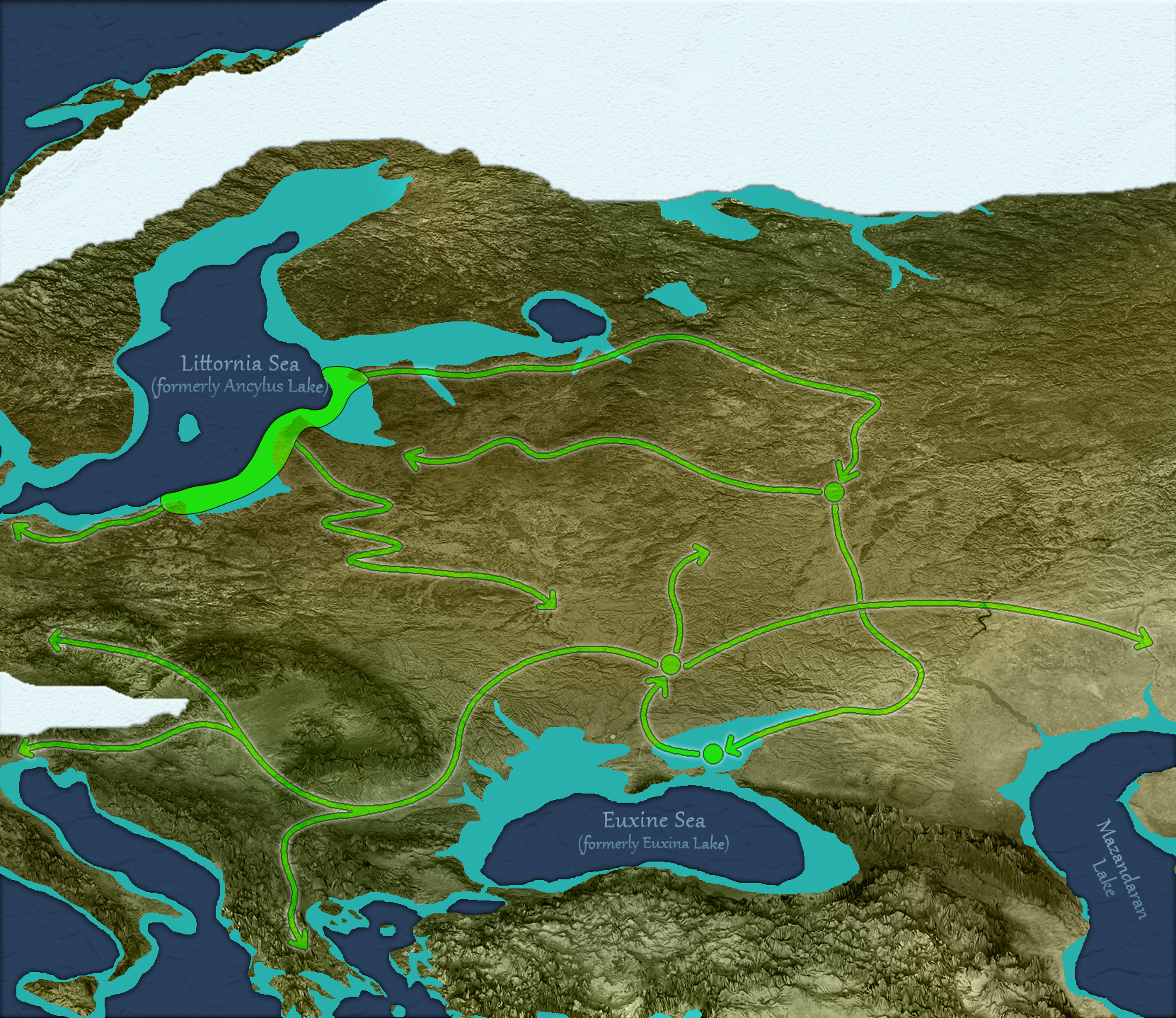Yék
Yék is the second youngest of the five original shared human languages.1 It emerged in 10,510 BP along the shore of Ancyllus Lake in Dnieper-Volga and the Variscides, became one of the most widely dispersed languages in Europe and Asia, splintered into various successor languages, and eventually died out by 7,685 BP.
Origin
The Sandarnans had developed a sedentary culture on the fertile plains exposed around the shores of Ancyllus Lake in 10,597 BP. Life was rich and easy, and clans traded and shared knowledge of toolmaking and building, and in the evenings they told eachother stories. The strong relationships that formed between sedentary clans gave rise to the standardization of communication that became the Yék language.Development
Sandarnan culture thrived by the water for many generations, not realizing that the rapid rise of ocean levels was creating a dangerous discepency between the level of the ocean and the level of their lake. When the water finally broke through in 9,960 BP it created an enormous influx of water that flooded the entire region, creating Littornia Sea. The Sandarans had built their permanent settlements so close to the shore that most of them were wiped out. The survivors fled toward the west and north into Skáney and toward the east and south into the Sarmatic Plain. Each of these surviving groups brought their own dialects of Yék with them, that subsequently evolved into their own successor languages.Extinction
The survivors in Skáney integrated with the native culture already there, and their language also evolved into a distinct successor language Ǵéwek. Yék continued to be used by the Kundans during their nomadic phase, but once the population reached the Caucusus, the language of the sedentary people building homes along the shores of Euxine Lake were speaking a new variant of the language, Yékke. The last speakers of true Yék died out some time before 7,685 BP.Structure
Note: This section on language structure is intended only as a quick overview of a few specific linguistic features, and not a comprehensive description of the language.
Phonology
In addition to many familiar consonants, Yék also had a wider variety of stop placements than many modern languages:
Interestingly, voiced frictives are not found in yék, although the /s/ phoneme could range from /s/ to palatalized /ɕ/ or /ʃ/ depending on its context. A vocalization of /s/ as /z/ sometimes emerged by accident when the phoneme was surrounded by voiced consonants, such as in the word nisdós ("nest"). However, the voiced frictive did not become a phoneme until successor languages.
The Yék phoneme set was limited to two short vowels (ɛ, ɔ) and two long vowels (e, o), and two surface/frontal vowels (i, u). These were able to combine as dipthongs which are usually expressed using a vowel-semivowel annotation, e.g.: ey, oy, ēy, ōy, ew, ow, and so on.
Unaspirated unvoiced stops
p, t, c, k, ʔ
Unaspirated voiced stops
b, d, g, ɟ
Aspirated voiced stops
bh, dh, gh, ɟh
Unvoiced frictives
s, x, χ, h, ħ
Nasals
m, n
Liquids
r, l
Morphology
Yék was an inflected fusional language, so that grammatical role and relationships between words was conveyed by conjugations, declentions, and suffixes. Nominal words (e.g. nouns, pronouns) had the morphological categories of gender (masculine, feminine, and neuter), number (singular, dual and plural) and case (nominative, accusative, vocative, genitive, ablative, dative, locative, and instrumental). Number was shared with verbs, while gender and case were not. Both noun stems and verb stems were divided into the classes thematic and athematic, the former ending in the thematic vowel. Their inflection partially differed.
This table illustrates the standard (but not universal) nominal inflectional endings in Yék:
This table illustrates standard verb endings in Yék:
numbercase
athematic
thematic
singularnominative
-s (neuter Ø)
-os (neuter -om)
singularvocative
Ø (neuter Ø)
-e (neuter -om)
singularaccusative
-m (neuter Ø)
-om (neuter -om)
singularinstrumental
-éh
-oh
singulardative
-éy
-oey
singularablative
-és
-o'od
singulargenitive
-és
-osyo
singularlocative
Ø
-ey
dualnom / acc / voc
-ih
-oy
dualinst / dat / abl
-bhām
-ōs
dualgen / loc
-ows
-oħom
pluralnom / voc
-es (neuter -χ)
-ōs (neuter -eχ)
pluralaccusative
-ns (neuter -χ)
-ōns (neuter -eχ)
pluralinstrumental
-bhi
-ōys
pluraldat / abl
-móshi
-oymos
pluralgenitive
-óħom
-o'oħom
plurallocative
-sú
-uysu
numberperson
athematic
thematic
singularfirst
-mi
-oχ
singularsecond
-si
-esi
singularthird
-ti
-eti
dualfirst
-wos
-owos
dualsecond
-t'hes
-et'hes
dualthird
-tes
-etes
pluralfirst
-mos
-omos
pluralsecond
-te
-ete
pluralthird
-nti
-onti
Syntax
The default, unmarked word order in Yék was SOV, for example:
Translation: "The king wants a son."
However, morpological markers conveyed so much meaning in Yék that word order was relatively unimportant as a grammatical indicator. Instead, word order was often used for emphasis: people would put the most important word at the beginning of the sentence regardless of whether it was the subject, verb, or object of the sentence. Pitch could also be used for emphasis, allowing for a complex range of ways a speaker could craft a sentence depending on what they wanted to convey.
ɣrḗḱs
súhxnum
u̯l̥nhto
king
(nominative)
(nominative)
son
(accusative)
(accusative)
desire
(1st, singular)
(1st, singular)
Vocabulary
Personal Pronouns
Yék had personal pronouns in the first and second grammatical person, but not the third person, where demonstrative pronouns were used instead.First Person
SingularPlural
SingularPlural
Second Person
SingularPlural
SingularPlural
Nominative
heǵwei
tuħyuħ
Accusative
hmén̥smé
twéusmé
Genitive
hménensero
teweusero
Dative
hméǵhionsmei
tébhiousmei
Instrumental
hmoínsmoí
toíusmoí
Ablative
hmednsmed
tuedusmed
Locative
hmoínsmi
toíusmi
Numbers
one
χóynos
two
duwóh
three
tréyes
four
ketwóres
five
pénkwe
six
swéḱs
seven
septḿ̥
eight
ɣeḱtṓ
nine
hnéwn̥
ten
déḱm̥
Source Region
Source Culture
Sandarnan People
Spoken by
Used From
10,510 BP
Used Until
7,685 BP
Writing System(s)
none2
Details and Highlights
1. A "shared" language is a language that is used by a population larger than one or two extended family clans. Shared languages began to arise among groups of human clans that were sedentary or semi-nomadic, and in settings that incentivized cooperation. This created social pressure to simplify and standardize communication across larger populations. Five shared languages emerged independently among humans at different times and in different regions. These five original shared languages, in order of appearance, were:
- Kx’wi (22,350 BP - 18,950 BP)
- Vadana Lipī (14,500 BP - 8,000 BP)
- Pūraw (12,900 - 9,000 BP)
- Yék (10,510 BP - 4,550 BP)
- Yányǔ (9,900 BP - 4,950 BP)






